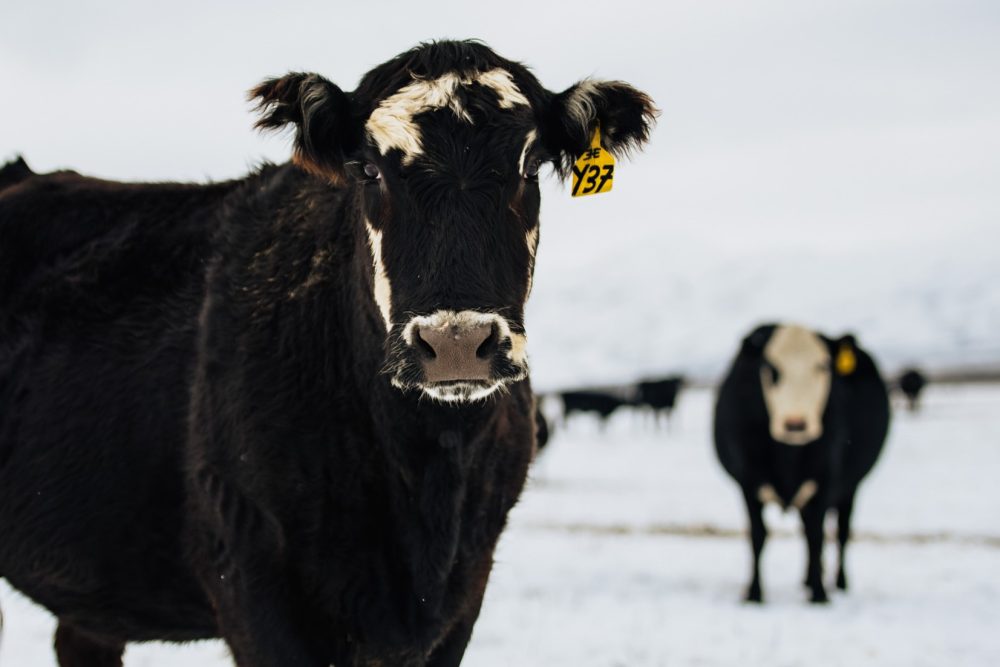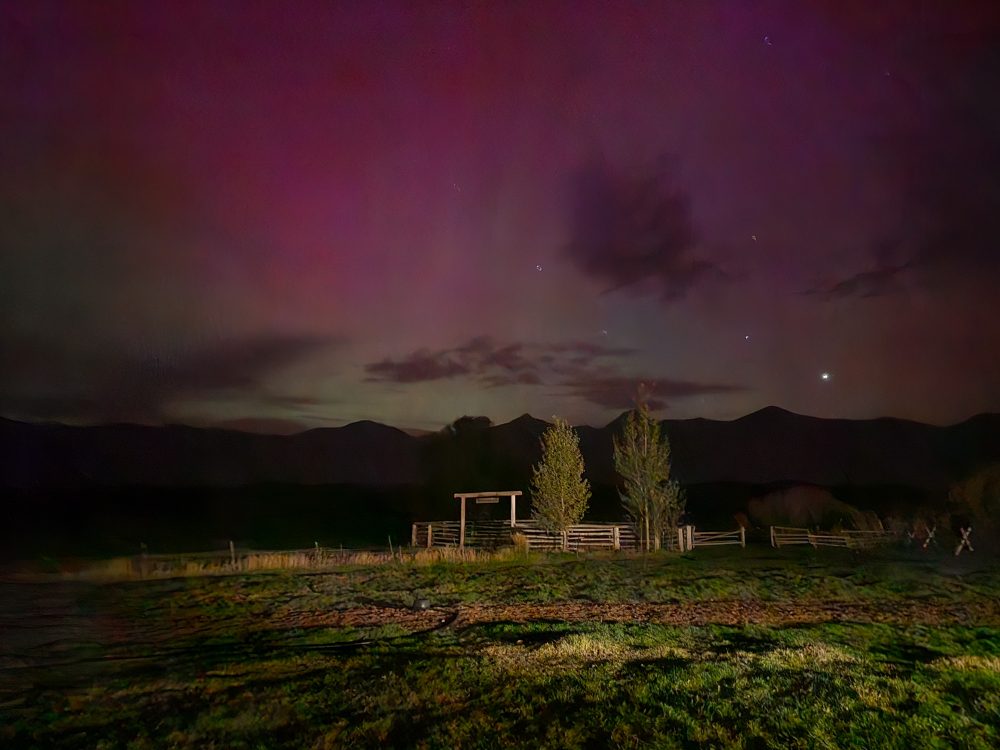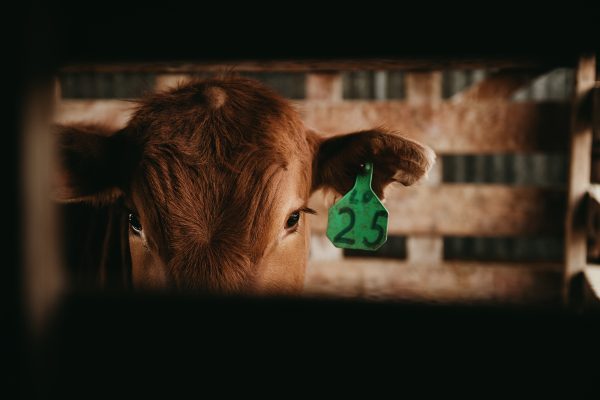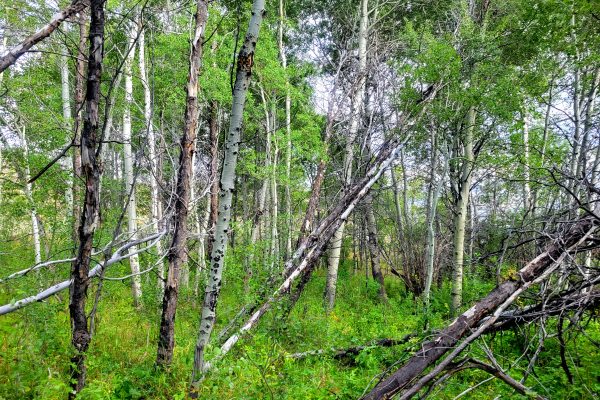Dear Friends
This Tuesday Morning: 2:20 AM: I flicked the barn lights on, and the new LEDs instantly burned bright (there are some things about technology that has made our lives better, it seems). Our 130-foot long barn structure is now easily illuminated from one end to the other. I made my way down along the cattle chute. We decided to finally have all of our cattle handling gear under roof, and I am grateful. I’ve put many years of dues working wild beef cattle in 2 feet of snow, pouring rain, 60 mph wind or all three at the same time. As I got the gates and loading chute ready, I reflected on life—a simpler, and a much less well-lit time when we first started ranching.
First barn: 15 by 25 feet, made of logs, unchinked, gaps whistling with winter wind. Light by the glow of a kerosene hurricane lamp. I’m trying to convince a brockle-faced cow to step into a head catch so I could simply just help her. Her calf was bug-eyed, sort of watching me walk, head hanging from the cow’s backside. His nose is swollen. Edema, from birth canal pressure. He’s hopelessly stuck, head and one foot protruding from his mother’s vulva which is swollen and sloppy with the hormonal softening flow of pregnancy. He will die soon if I don’t manage to get him out. In the feeble light I murmur a prayer that this time I’ll be able to get her neck caught in the head catch.

This is a brockle-faced cow. Webster’s never heard of this term; it’s a black and white speckle-faced black Angus-cross cow.
It’s the fourth time I’ve tried, and she’s kicked, dodged, bellered, and nearly ran over me in this, the 12 by 12 pen of the 15×25 foot space of the roughshod space of lodgepole pine log barn. It may be the last chance I get before she either kills or injures me, or blows through or over the interior barn pole fence. Both have happened several times in the past years, despite my attempts at calm, cool and reassuring.
Wild range cows are not into confined spaces. Especially in close proximity to humans.
But the fourth time was the charm, and thank God, I’ve finally got her. Hurrying, I nearly rip off my coat, sweater, shirt, wool top underwear, exposing bare bleached freezing goosebump skin. It’s 30-below zero outside and a balmy minus 20 in the barn. She swings wildly, and tries to get a piece of my white-naked guts with a well-placed but not perfectly aimed 70 mile-an-hour back foot kick. Determined, I commit. Pushing hard against her back legs to reduce her kick momentum, my white arm reaches deep into her backside and finally finds that leg that’s twisted and bent backwards in what vets call ‘poor presentation.’ The first word is the one I’m really having to deal with: poor. She and calf will likely die unassisted, as the leg bend prevents any further progress through the birth canal. Simply put, the elbow of calf is hung up at the bony pelvic canal of the mom.
With my arm trying to manipulate the problem leg, the cow finally begins to settle, sensing relief. Up to my armpit in the birth canal, she contracts with all the uterine strength of a 1400 pound experienced black Angus mama. I winced in pain at the absolute all-encompassing pressure and subsequent numbness of the contraction, but as soon as it is past, I dove even deeper along the leg, quickly cupping the recalcitrant hoof carefully in my hand so I didn’t scratch her uterine wall as I gingerly pulled arm and hoof out into flickering lanternlight.
Now two perfectly buttery soft white hooves poke out, cradling a swollen nose having trouble getting any breath (before it was hard enough for him to inhale during her contractions). No time left. I pull, both hands: nothing, no traction, never will happen. I have OB chains, shiny albeit dusty stainless steel ones hanging from a nail by the flickering hurricane on the potato chip-like bark covering the pine log wall (the barn is rough). I throw them around hooves, chain slip through loop, a natural slip knot. I have only one big stainless handle; I’m certain the other is in the dusty straw and manure matrix at my feet. No time to lose, and no Nolvasan on the chains because the infection potential is non-existent as the feet are already out.
I pull. Leaning back and down in a natural arch that follows the downstream flow of birth canal (“never up,” said Ron Alder, the wizened cowboy teacher to me of all things cow, unless you have a cow with crappy hind end uphill confirmation like so many poorly bred dairy cows of today!). The second the cow feels my pull she immediately helps with a serious, well executed contraction. She absolutely knows. No more fight. Pure and simple human and animal teamwork; a contractual business transaction born of necessity. Although a range wild wolf fighting and bear kicking bitch bovine mama, she settles into this unlikely partnership and is with me. All the way.
Her commitment is clear as she grunts when I do, and ears twitch back when I offer encouraging words: “Come-on girl. Push! COME ON! We’ll get her!” Her body curls up to an arch with an incredible push. Calves eyes bulge nearly popping out of sockets. I spread and twist the feet while gently pulling now—actuating the rotation of the whole front of calf on my next pull, unlocking the shoulders in the pelvic arch as we slip free of a combination of swollen blood engorged muscle and the unyielding rigidity of pelvic bone.
And with that, the unlocked calf surges forth in fluidity; with him comes a tremendous surge of amnion, covering me in the warm sweet bovinesque ripeness that birth brings. Calf lands on warm straw, in shock, twitching. Eyes blinking. He’s alive. Meanwhile, cow collapses from exhaustion. Baby still blinking but obviously not breathing. Dying. “Come on, baby!” I grab a tiny piece of clean straw from the floor of the stall, and tickle the inside of swollen nostril in another practice of Ron Alder’s millennia-old pioneer wisdom.
Reflex button now pushed, calf stops blinking, body tensing, arching for what absolutely must follow.
He sneezes, releasing a tremendous shot of amniotic fluid from nostrils. And begins breathing. Shallow, gurgly, snotty at first, then, in big breathy draws amidst more sneezes. I run to the headcatch and let mama loose. She swings around, staggering; she almost collapses again, but gathers up all she has left. After all, she knows the drill as any experienced mother would, and puts her head down and draws a big satisfying inhale at her kid. She lows, a deep heartfelt moo, as if saying “Yes. He’s mine.”
And that was my signal. Reflex kicked on in my mind, and even my body knew it was time to vacate. Immediately. Right now. I threw my clothes over the pole pen fence, grabbed my lantern, and launched my afterbirth drenched white-skin body over just as she hit my feet with an angry nose. She kindly helped me right over those rails.
She would have killed me, I think. No thanks from her tonight, or any night.
But her behavior was just right. After all, who else would fight off the likes of a 145-pound winter-hungry wolf and protect that baby on a cold winter night?
No-one. But her. She alone would stand her ground. And most likely, the wolf would leave.
++++++++++++
I reached for the light-switch that would shine floodlights on the barnyard, and clicked them to ‘on.’ Nothing. The bulbs must be burnt. I looked back in the bright barn, and wondered about the midnight moonless blackness. Although I was comfortable in the dark (there’s hardly a light in our dark sky valley, and certainly not up on the range in cow camp), I needed at least some light to find my cattle. I thought back as to why I kind of liked the soft glowing kerosene lantern. It would be far less insulting, intrusive to the cows outside. As it was, I thought I was going to have to go back to my pickup to grab the LED flashlight so I could gather my beeves that were bound for Montana.
I stepped out into the October night out of the sterile glare of the barn lights. My eyes strained for my charges. I had to find them because it was harvest time, and 14 head that Melanie, Annie and Webb sorted off from the herd the day before had reached their prime on the grasslands of Alderspring. They were ready, and I had come to gather them, say goodbye and load them on my long gooseneck trailer for a cool nighttime ride over the Continental Divide.
This loading and sorting time is always a melancholy time for us, because these beeves aren’t any sort of commodity to us. They never are. Ultimately, they are food for all of us and you, dear reader partners, but the animal earns sort of a place in our hearts. We’re not really friends, as you could see from the cow encounter I recalled in the words above. But we have lived in mutual respect for one another.
And I hate to see them go.
As my eyes got used to the dark, I noticed it wasn’t quite that—dark, I mean. Sometimes, the simplest things are the times where I find I have the greatest gratitude. I could easily find the 14 in the corral under the light that surpassed that of the old hurricane lantern. It was literally the lights of the heavens: The Northern Lights. Arcs and orbs and beams and curtains of pink, green, orange and red lazily slow danced silently along the crest of the Lemhi Mountain range. Familiar friends like the Big Dipper, Orion, and the belt of the Milky Way stood by, shining over the dance floor, watching the performance of Aurora Borealis. I wondered if the beeves watched too as they chewed cud through the night. They alone could tell stories of the night that we never would know of. They are out there, all the time, eyes open, at rest, always watching. The ethereal lights almost cast discernible shadows along the glowing luminescence they created in the graying timbers of the corral fence as steers single filed along it toward the light of the barn.

+++++++++++
Certainly this ranching life in the outback isn’t for everyone. It’s a hard life. It’s hard on families and marriages. We get pretty isolated. But it’s often full of the wonder of raw nature at a deeply personal level. I’ve found cryptic-camouflaged colored newborn pronghorn antelope kids tucked under sage while mom watches from a distant ridge, trying to draw me away (she’ll remember where they are). We’ve heard wolves howl at midnight over the hiss of the Coleman lantern while we fixed dinner in the canvas wall tent. They were celebrating a fresh elk kill on the ridge above camp, within a few hundred yards of our 450 head in their hotwire night pen. This summer, the range crew had mountain lions calling (and crawling) around their camp.
And then, we become viscerally aware that it isn’t all thriving resplendent life and living. The struggle to live is continuous; we sometimes get swept away in the cycle of life and death. We’re inextricably intertwined with it all to the point that even our own blood gets shed, and our own bones broken. It’s certainly not a safe life, but it’s for real. It’s not some contrived life as on social media or a TV series. Interns who come work for us get a very quick study on the importance of what they do; either they sustain and enhance life, or, if they fail, they extract from life.
Despite those real struggles, ironically, it’s often the subtle things; the nuance that create the most vivid memories. Things like the light of lanterns and a calf being born– and the glowing lights in the heavens create memories not easily forgotten.
I wouldn’t have had it any other way, I think. But I’ll still keep the LEDs in the barn.
Happy Trails.
Glenn







Natalie
What. A. Story!
Thank you for sharing… and enlightening.